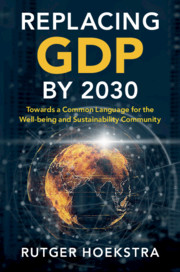Book contents
- Replacing GDP by 2030
- Advance Praise for Replacing GDP by 2030
- Replacing GDP by 2030
- Copyright page
- Dedication
- Contents
- Figures
- Tables
- Boxes
- Preface
- Acknowledgements
- Part I Why a New Strategy Is Needed
- 1 Replacing the Most Influential Indicator in the World
- 2 Why Is GDP Successful?
- 3 What Does GDP Measure (And What Not)?
- 4 Why Is Beyond-GDP Not Successful?
- Part II The New Strategy: A Community for Well-being and Sustainability
- Annex: Beyond-GDP Milestones and Measurement Systems
- Notes
- References
- Index
3 - What Does GDP Measure (And What Not)?
from Part I - Why a New Strategy Is Needed
Published online by Cambridge University Press: 24 May 2019
- Replacing GDP by 2030
- Advance Praise for Replacing GDP by 2030
- Replacing GDP by 2030
- Copyright page
- Dedication
- Contents
- Figures
- Tables
- Boxes
- Preface
- Acknowledgements
- Part I Why a New Strategy Is Needed
- 1 Replacing the Most Influential Indicator in the World
- 2 Why Is GDP Successful?
- 3 What Does GDP Measure (And What Not)?
- 4 Why Is Beyond-GDP Not Successful?
- Part II The New Strategy: A Community for Well-being and Sustainability
- Annex: Beyond-GDP Milestones and Measurement Systems
- Notes
- References
- Index
Summary
GDP is a measure of economic activity but some economists are critical of this application. “An economy” is not an observable phenomenon and defining its “production boundary” is a matter of convention rather than an objective activity. There are many other methodological, theoretical and practical considerations which have become even more problematic because of ICT and globalisation. Other criticisms focus on the fact that GDP does not measure well-being, sustainability (or any other aspect of the future) or inequality. Some argue that GDP is a good proxy for the quality of life, because income is a necessary condition for positive aspects of lives such as education and health. This may be the case from a very long-term perspective or for developing countries, but many publications suggest that this conclusion is flawed because over the last few decades GDP has grown while well-being has not. Growing inequality, stagnant labour incomes and growing environmental pressures overshadow the growth of GDP.
Information
- Type
- Chapter
- Information
- Replacing GDP by 2030Towards a Common Language for the Well-being and Sustainability Community, pp. 54 - 78Publisher: Cambridge University PressPrint publication year: 2019
